 |
||
|
||
| ||
The launch of the Intel LGA775 platform last year was an important event, one can even say epoch-making — for the first time the industry got a really rich compilation of fresh technological trends that can shape a new backbone for computer systems. As usual, there were some rumours (including utterly negative and sometimes not groundless, if you face the truth), but the LGA775 platform steadily won its place in the sun, missing no opportunities to demonstrate advanced technical qualities and wide development prospects. What concerns those false rumours, one of their sources was a boss-shot with coolers: while there was no getting rid of solutions in the high-end sector by the debut of the new platform (leading cooler makers managed to find their bearings in time and launched a whole range of cooling systems adapted for LGA775 — mostly multi-platform models), the low end sector offered practically no alternatives and was totally dominated by the boxed cooler and its few clones, based on an expensive reference design. As a result, the minimal price tag for low end LGA775 coolers starts from 15-16 USD (that is twice as high as typical models of a similar category for Socket 478 and Socket 754/939 platforms) - bad news for zealous users and no less economical PC integrators. Fortunately, the field of low end coolers was not left in utter desolation, this summer is marked by a cohort of new economy models at adequate prices that appeared due to vendors' efforts. The most significant role in this positive recultivation has been played by GlacialTech that has grown three series of low and middle end coolers — Igloo 5050, Igloo 5070, and Igloo 5600. Our today's review will be devoted to coolers from these series. Igloo 5050 Light, Igloo 5050, and Igloo 5050 PWMThe new GlacialTech line is opened by the low end Igloo 5050 models — Igloo 5050 Light, Igloo 5050, and Igloo 5050 PWM. These coolers are based on the same aluminum 88x42 mm heatsink with radial finning, equipped with 90x90x25mm fans (Everflow R128025DM, R128025DH, and R128025DU) and ranked by their rotational speed (nominal 2400, 2800, and 3800 rpm correspondingly). A fan in the Igloo 5050 PWM is additionally equipped with an rpm control circuit — it allows to vary the rotational speed of the fan from 1000 to 3800 rpm via system monitoring on a motherboard (when connected to a corresponding 4-pin connector). 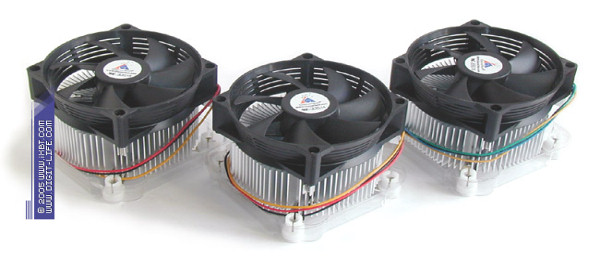 Despite its low end origins, the Igloo 5050 series actually possesses good technical insides. The main marvel here is a fan of a cunning design: a convergent (in the forward direction of the air flow) pipe in the form of a grill (which actually "converts" 90x90mm into 80x80mm) significantly improves the flow of this fan and also increases the static pressure of the airflow (due to the taper) and volume speed (due to the secondary air intake via the pipe grill). As a result, the real effective performance of a fan is increased significantly and provides an amplified air flow through the heatsink. 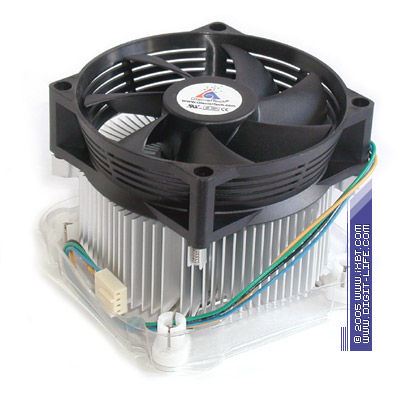 The Igloo 5050 heatsink also looks neat — demonstrating a simplified radial configuration, it nevertheless possesses developed finning with a decent set of parameters (the average fin thickness is 0.8 mm, the total heat exchange surface - ~1300 cm2). Together with its advanced fan, this heatsink is most likely capable of making up a good low-end thermal duet.  The mounting system of Igloo 5050 should be mentioned separately. Unlike the reference design (where a cooler is fixed to a motherboard by special plastic cambric locks through the mounting holes), this mounting set includes an additional supporting plate (mounted at the back of the socket), the mounting bracket of a cooler is attached to this plate by screws. This installation method requires some skill and is less convenient than the reference method, but the screws provide tighter and more robust installation of a cooler into the socket. It significantly improves the quality of a thermal contact between a processor and a heatsink. 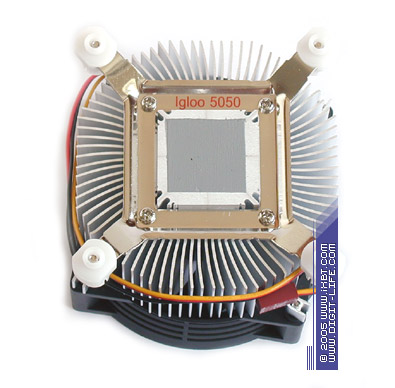
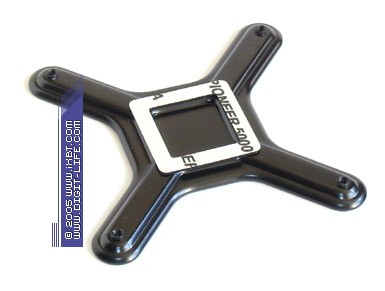 Low end Igloo 5050 coolers do their duty well — of course, they cannot boast of champion results (the heatsink construction is too simple for these days), but they can still provide acceptable thermal efficiency. Igloo 5050 puts up the best performance — this lad outperforms the robust clone of the reference design — Titan TTC-NH08TB/932/PW (2800 rpm) and is slightly behind the boxed cooler, managing to keep within the acceptable noise level. Igloo 5050 Light and Igloo 5050 PWM are also on firm ground, but they demonstrate in-and-out performance: Igloo 5050 Light, even if offering more humane noise ergonomics, loses some thermal efficiency, while Igloo 5050 PWM scores additional points solely due to high rotational speed of its fan (and a significantly higher noise level). Igloo 5070 Light, Igloo 5070, and Igloo 5070 PWMThree other low-end models (Igloo 5070 Light, Igloo 5070, and Igloo 5070 PWM) are equipped with the same 90x90x25mm fans as in the Igloo 5050 series. They feature an identical mounting system, but possess an enlarged aluminum 88x94x54mm heatsink with more habitual plate finning. The PWM model, by analogy with Igloo 5050 PWM, is equipped with a rotational control circuit (the rotational speed varies from 1000 to 3800 rpm).  Besides the enhanced dimensions/weight and enlarged heat exchange surface (about 1600 cm2), Igloo 5070 heatsink also carries reinforced finning: here we can see thermal efficiency catalysts, traditional for GlacialTech coolers — tapered section fins (0.7mm thick at the base and 0.3mm thick at the tip) and fin height alternation, which enhance thermal efficiency of the finning and improve the air flow through the heatsink. Another feature of the Igloo 5070 is wave-like bulges at the base, which provide optimal conditions for heat distribution in the working medium of the heatsink - which serve to minimize the effect of resistance to the spreading of the heat flow and reduce the contact thermal resistance of the processor/heatsink pair. 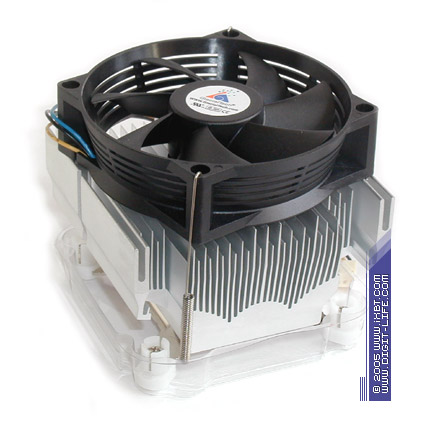 What concerns service properties, the Igloo 5070 models are practically similar to the Igloo 5050 — these coolers have identical mounting systems (they are fixed by screws to the bundled plate through mounting holes on a motherboard) and are equipped with preinstalled thermal paste, of high quality and efficient at that (its filling agent is an aluminum oxide and aluminum nitride compound). Despite the large heatsink dimensions, access to the screws is open (facilitated by the fan placed at a small angle and by special notches in finning).  But the Igloo 5070 looks more promising in thermal terms: having obtained an efficient doping — a heatsink with developed finning, these coolers can reach comfortable temperatures. The Igloo 5070 PWM shoots forward here and catches up with the thermal efficiency of much more expensive coolers (but as in case with the Igloo 5050 PWM, it costs dearly — it comes at a price of a high noise level). The most interesting results are demonstrated by the low-speed Igloo 5070 Light — the cooler keeps the core temperature of the Pentium 4 550 processor within the standard "thermal envelope" without crossing the maximum threshold of 85°C (the technical threshold, beyond which the long reliable operation of a processor is jeopardized) and retains ergonomic noise characteristics. Igloo 5600 Light, Igloo 5600, and Igloo 5600 PWMThree top models in the GlacialTech family bring up the rear in our list — Igloo 5600 Light, Igloo 5600, and Igloo 5600 PWM. The coolers are based on an advanced heatsink, larded with a couple of copper heat pipes. They are equipped with 80x80x18 mm fans (Everflow R128018DL, R128018DM, and R128018DH) and traditionally ranked by the rotational speed (2400, 2800, and 3600 rpm correspondingly). The PWM model, as well as the low end Igloo 5050 PWM and Igloo 5070 PWM, is equipped with the rpm control circuit (the rotational speed varies from 1000 to 3600 rpm). 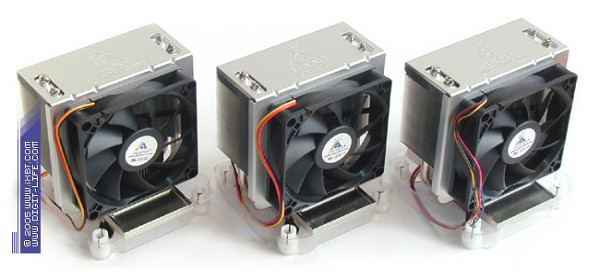 The general spirit of the Igloo 5600 is a heatsink of an original combined construction based on classical principles of the heat pipe technologies — the working medium here is formed by two 6mm heat pipes and a section of aluminum heat dissipating 0.2mm plates (37 plates, the total heat exchange surface is about 2600 cm2). A nickel-plated copper anvil (33x33x6mm) is used as a base (in other words, a heatsink).  This entire heat exchange system is spiced up with an additional aluminum 50x90x29 mm heatsink, notable for very good finning parameters (tapered section fins - 0.7mm at the base and 0.3mm at the tip at 1 mm steps, the heat exchange surface is about 500 cm2). It acts like an interface between the heatsink and the heat pipes; it also provides additional heat removal from the hottest areas. 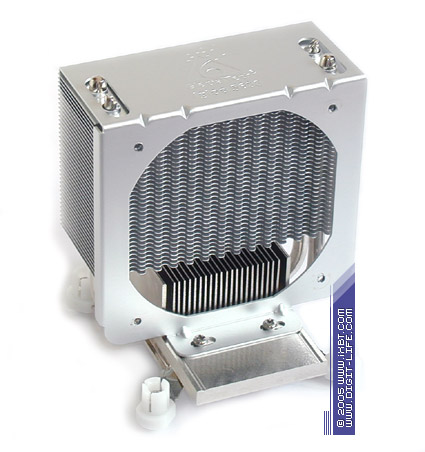
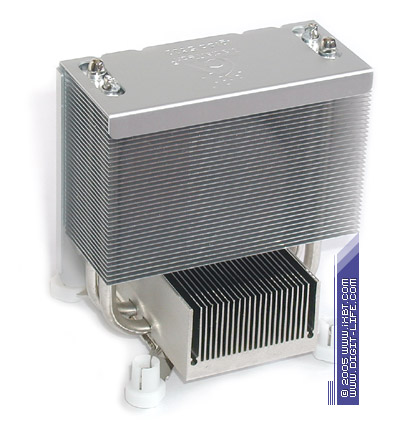 As we have already written in the Multi-platform cooler Gigabyte PCU21-VG article, the classic design of cooling solutions based on heat pipes comes with a number of problems, which may lead to a serious drop of their thermal efficiency. It probably required much efforts from GlacialTech engineers to find an optimal solution, as the effect of negative factors in the Igloo 5600 is minimized: larger steps of plate fins (2 mm), rather short inter-fin heatsink channels (40 mm), and an improved air inlet (a special wavy profile) — the complex of these measures contributes to the pressure loss of a heatsink (it gets easier to blow through) and correspondingly amplifies the heat exchange intensity. Another important technical issue — the heat pipes are soldered to the base and the additional heatsink to ensure excellent thermal contact and thus to reduce the thermal resistance of the entire device. 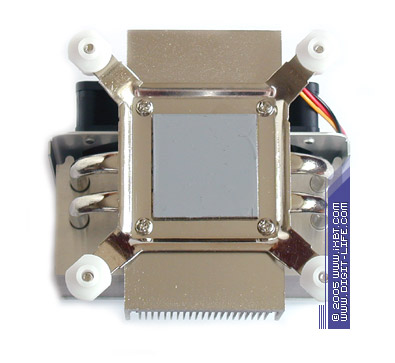 As we can see, the Igloo 5600 series has an excellent thermal benefactor (the advanced heatsink) and thus evokes serious hopes for impressive thermal efficiency. To the credit of these coolers, practice measures up to our expectations completely — Igloo 5600 doesn't miss a chance to realize its potential and demonstrates results similar to high-end products. For example, Igloo 5600 PWM pulled ahead in our today's tests, it outperformed a serious competitor — Zalman CNPS7700-Cu (by the way, we had expected higher performance from the latter model, but it seemed to retain some LGA775 mounting defects) and yielded the palm only to the athlete from Thermaltake — Silent Tower, equipped with two fans. Igloo 5600 and Igloo 5600 Light also demonstrate excellent results — these coolers compete well with the Zalman CNPS7700-Cu, as well as with the advanced Titan Vanessa S-type, demonstrating equal (in ergonomics) or even lower noise level. So, let's wind up our today's review of new coolers from GlacialTech. It seems high time to draw the bottom line. But before that, let's have a look at the test results. Test resultsIn order to examine thermal efficiency of our LGA775 coolers, we use the same methods as in testing cooling systems for Socket A, Socket 478, and Socket 754/939. The primary data used for the consequent calculation of thermal resistance is also temperature readings of the thermal diode built into a processor, only the thermal source is different (now it's Pentium 4 550 processor), the base platform (ASUS P5AD2-E Premium motherboard), and a set of test applications. The testbed has the following configuration:
We use the S&M utility to simulate maximum thermal load of a processor, and Speedfan - to monitor temperatures. Thermal Monitor is disabled in all the tests. Diagram 1. Temperature readings Notes Diagram 2. Thermal resistance Note Finally, at the end of this article we publish the noise measurement results (the method of testing is described in the article Noise characteristics of coolers and the noise measurement method) as well as the efficiency/noise rating of coolers. Diagram 3. Noise characteristics
Diagram 4. Efficiency/noise ratio Note There seems to be no need in any comments here. Let's draw the bottom line! ConclusionsThe new GlacialTech coolers for Intel LGA775 platform that passed the thorns of our tests, produce mostly positive impressions. Igloo 5600 coolers seem the most interesting and attractive models — these coolers demonstrate a well balanced combination of technical properties, provide comfortable temperature conditions even for top processors (up to 140-150W of heat release, which corresponds to Pentium 4 670-like models), and compete with more expensive cooling systems of the high-end class. Low end models Igloo 5050 and Igloo 5070 fair much lower and cannot offer really attractive results. But these coolers are doing quite well in their class (especially Igloo 5070). Considering all their pros (good efficiency, tolerable noise, firm mounting system, and a low price), they can be recommended for LGA775 processors of the low and middle price level (up to Pentium 4 550). Let's call it a day.
Write a comment below. No registration needed!
|
Platform · Video · Multimedia · Mobile · Other || About us & Privacy policy · Twitter · Facebook Copyright © Byrds Research & Publishing, Ltd., 1997–2011. All rights reserved. |